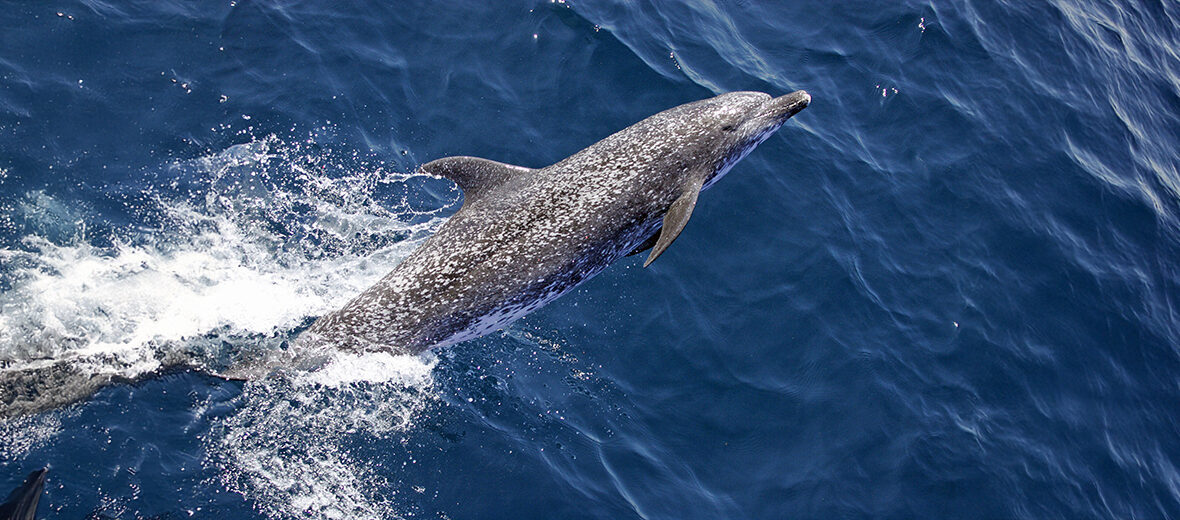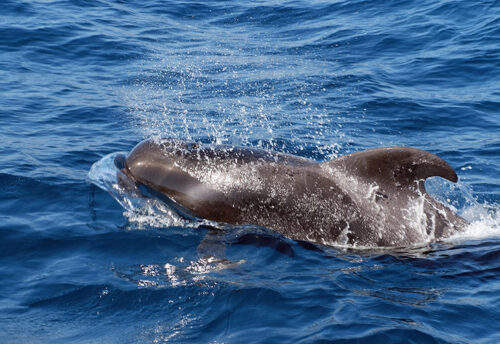
The Atlantic spotted dolphin prefers the warm temperate and tropical waters of the Atlantic Ocean. As they age, they acquire spots all over their body. They can be found not only in deep water but also off the coasts of North America, Mexico, Central America, South America, Europe, and Africa. Like other dolphin species these critters face the threats of incidental catches from bottom-set, drift gillnets, and possibly tuna purse seines. However, they are abundant enough to be listed as Least Concern by the IUCN. Their population trend is unknown though, at this time.
First the Stats…
Scientific name: Stenella frontalis
Weight: Up to 310 lbs.
Length: Up to 7.6 feet
Lifespan: Up to 35 years
Now on to the Facts!
1.) These dolphins were first described by Georges Cuvier in 1828.
2.) Atlantic spotted dolphins in the Bahamas have recently been observed mating with bottlenose dolphins.
3.) Rich LeDuc published data that suggested these dolphins may be more closely related to the bottlenose dolphins than to other members of the genus Stenella.
4.) Recent studies in the 2020s have indicated that this is a consequence of reticulate evolution (reticulate evolution, describes a pattern of evolution where lineages merge or intersect, resulting in a network-like pattern of relationships rather than a simple branching tree).
5.) This explains why the Atlantic spotted dolphin can successfully mate with both species of bottlenose dolphins.
But wait, there’s more on the Atlantic spotted dolphin!
6.) These dolphins are capable of around 10 different vocalizations, including barks, buzzes, squawks, and whistles; each corresponding with different behaviors.
7.) Being very gregarious, these dolphins often gather into pods of up to 15 individuals, while intermingling with bottlenose dolphins.
Did you know…?
These fast swimming dolphins can reach speeds of up to 20 mph and are known for bow riding and elongated, shallow leaping behaviors.
8.) Females undergo up to an 11 month gestation (pregnancy) that yields a single calf.
9.) Calves can measure up to 43 inches.
10.) The female’s calf is cared for for up to 5 years.
But wait, there’s still more on the Atlantic spotted dolphin!
11.) These dolphins are primarily nocturnal (active at night). However, they can be active during the day as well.
12.) Their prey consisting mostly of of small fish, benthic invertebrates, and cephalopods like squid and octopus is hunted strategically in groups via encircling.
Did you know…?
They can dive to depths of up to 200 feet and hold their breath for up to 10 minutes at a time.
13.) Aggression shown towards other dolphin species is displayed via biting, butting, and chasing.
14.) Around 20 years ago, only approximately 80 dolphins were in the Bahamas. Now, nearly 200 dolphins are found there.
15.) These dolphins are included in the Memorandum of Understanding Concerning the Conservation of the Manatee and Small Cetaceans of Western Africa and Macaronesia.
Now a Short Atlantic Spotted Dolphin Video!
Be sure to share & comment below! Also, check out the Critter Science YouTube channel. Videos added regularly!
Want to suggest a critter for me to write about? Let me know here.
Some source material acquired from: Wikipedia & IUCN
Photo credit: NOAA Southeast Fisheries Science Center




